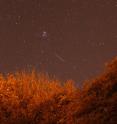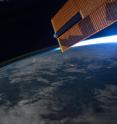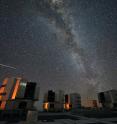Perseid meteors could see 'surge in activity' on Aug. 11-12
Related images
(click to enlarge)
Friday 12 August sees the annual maximum of the Perseid meteor shower. This year, as well as the normal peak on the night of 12/13 August, meteor scientists are predicting additional enhanced activity in the shower the night before, as the Earth passes through a dense clump of cometary debris. Meteors (popularly known as 'shooting stars') are the result of small particles, some as small as a grain of sand, entering the Earth's atmosphere at high speed. The parent comet, Swift-Tuttle, which last passed near the Earth in 1992, leaves this debris in the Earth's path. On entering the atmosphere, these particles heat the air around them, causing the characteristic streak of light seen from the ground. The meteors appear to originate from a single point, called a 'radiant', in the constellation of Perseus, hence the name of the shower.
Russian astronomer Mikhail Maslov and Finnish astronomer Esko Lyytinen predict that this year the Earth will pass through a stream of cometary material shifted towards us by Jupiter's gravitational field. According to their model, and work by French scientist Jeremie Vaubaillon, we could see a steep rise in activity from late evening on 11 August to 0500 BST on 12 August.
The Perseids are typically active from around 17 July to 24 August, although for most of that period only a few meteors an hour will be visible. During the peak, and if the predictions by Maslov, Lyytinen and Vaubaillon are right, as many as 100 meteors or more may be seen each hour. This year, the light from the waxing gibbous Moon will interfere to some extent for the first part of the night, so observers are advised to look out in the early morning hours after midnight when the Moon is very low in the sky or has set.
Professor Mark Bailey, Director Emeritus of Armagh Observatory, said "The Perseid meteor shower is one of the best and most reliable meteor showers of the year, and the predictions of a surge in activity this year make it particularly exciting this time. If you're lucky enough to have a clear sky early in the morning on 12 August, I'd definitely get up to take a look."
Dr David Asher, also at Armagh Observatory, continued, "If you're clouded out on the morning of the 12 August, you still have a chance to see the normal maximum the next night."
Unlike many celestial events, meteor showers are straightforward to watch, and for most people the best equipment to use is simply the naked eye. Advice from experienced meteor observers is to wrap up well and set up a reclining chair to allow you to look up at the sky in comfort. If possible it also helps to be in a dark place away from artificial light, and to have an unobstructed view of the sky.
Although the number of visible meteors is hard to predict accurately, you can expect to see at least one every few minutes. They mostly appear as fleeting streaks of light lasting less than a second, but the brightest ones leave behind trails of vaporised gases and glowing air molecules that may take a few seconds to fade.
Source: Royal Astronomical Society
Other sources
- Time-lapse images reveal Perseid meteors around the globefrom UPIThu, 18 Aug 2016, 18:51:16 UTC
- Specialized cameras capture the Perseid meteor shower from points around the globefrom PhysorgThu, 18 Aug 2016, 16:01:56 UTC
- Wow! Perseid Meteor Shower Fireball Inspires a Skywatcher Happy Dancefrom Space.comMon, 15 Aug 2016, 22:01:27 UTC
- Perseid Meteors 'Rain' Over California | Time-Lapse Videofrom Space.comSat, 13 Aug 2016, 13:51:14 UTC
- Skydivers Transform Into 'Shooting Stars' During Perseid Meteor Showerfrom Space.comSat, 13 Aug 2016, 0:21:13 UTC
- Skydivers Transform Into 'Shooting Stars' During Perseid Meteor Showerfrom Live ScienceFri, 12 Aug 2016, 19:01:13 UTC
- The Perseid meteor outburst did not disappoint! Look for more meteors tonightfrom LA Times - ScienceFri, 12 Aug 2016, 19:01:10 UTC
- Perseid Meteor Shower Peak Thrills Skywatchers: How You Can Still Watchfrom Space.comFri, 12 Aug 2016, 16:31:29 UTC
- Perseid meteor shower photos will inspire you to watch again tonightfrom CBC: Technology & ScienceFri, 12 Aug 2016, 14:11:16 UTC
- Time-lapse footage of Perseid meteor showerfrom BBC News: Science & NatureFri, 12 Aug 2016, 11:31:24 UTC
- Well: The Final Challenge: Meteor Shower!from NY Times HealthFri, 12 Aug 2016, 5:41:21 UTC
- Get a Sneak Peek at Perseid Meteors in This NASA Videofrom Space.comThu, 11 Aug 2016, 22:11:10 UTC
- Perseid Meteors Have Been Lighting Up NASA Cameras For Weeks | Videofrom Live ScienceThu, 11 Aug 2016, 21:01:34 UTC
- Perseid Meteors Have Been Lighting Up NASA Cameras For Weeks | Videofrom Space.comThu, 11 Aug 2016, 20:21:08 UTC
- 200 Meteors Per Hour Will Be in Tonight's Perseid Showerfrom MSNBC: ScienceThu, 11 Aug 2016, 19:31:19 UTC
- When and Where to Watch 200 Meteors in Tonight's Showerfrom MSNBC: ScienceThu, 11 Aug 2016, 18:31:23 UTC
- Early Perseid Meteors Wow 'Milky Way and Meteor Man' (Photos)from Space.comThu, 11 Aug 2016, 18:21:42 UTC
- Perseid Meteor Shower Weather Forecast: The Best US Views Are Out Westfrom Space.comThu, 11 Aug 2016, 17:21:23 UTC
- The Perseid meteor shower peaks tonight: How to watchfrom CBSNews - ScienceThu, 11 Aug 2016, 16:31:09 UTC
- Perseid meteor shower 2016: Once in a decade 'outburst' expectedfrom LA Times - ScienceThu, 11 Aug 2016, 16:21:20 UTC
- Perseid meteor shower 2016: Once in a decade 'outburst' expectedfrom LA Times - ScienceThu, 11 Aug 2016, 15:21:14 UTC
- See Mars, Saturn and Moon Align During Perseid Meteor Shower Tonightfrom Space.comThu, 11 Aug 2016, 12:21:30 UTC
- Perseid Lore: The Legend and Science Behind the Epic Meteor Showerfrom Space.comThu, 11 Aug 2016, 12:21:29 UTC
- Perseid Meteor Shower Peaks Tonight: Here's How to Watch Online (and Off)from Space.comThu, 11 Aug 2016, 11:51:16 UTC
- Perseid Meteor Shower to Light Up Night Skyfrom MSNBC: ScienceThu, 11 Aug 2016, 11:01:14 UTC
- Extra-spectacular Perseid meteor shower peaks tonightfrom CBC: Technology & ScienceThu, 11 Aug 2016, 9:21:21 UTC
- Bright Planets Add More Dazzle to Perseid Meteor Shower's Peakfrom Space.comWed, 10 Aug 2016, 19:51:17 UTC
- Outburst of shooting stars up to 200 mph - meteors per hourfrom PhysorgWed, 10 Aug 2016, 19:22:58 UTC
- Outburst of shooting stars up to 200 mph - meteors per hourfrom AP ScienceWed, 10 Aug 2016, 19:22:40 UTC
- Trilobites: Get Ready for the Perseids Meteor Shower: ‘It Will Rival the Stars in the Sky.’from NY Times ScienceWed, 10 Aug 2016, 16:41:15 UTC
- Perseid Meteor Shower Quiz: Test Your Cosmic Fireworks Smartsfrom Space.comWed, 10 Aug 2016, 15:31:12 UTC
- Perseid meteors could see 'surge in activity' on Aug. 11-12from Science DailyWed, 10 Aug 2016, 13:31:59 UTC
- Perseid Meteor Shower 2016: Sky Maps and Viewing Guide (Gallery)from Space.comWed, 10 Aug 2016, 12:01:28 UTC
- Perseid meteor shower 'surge in activity' Thursday, Fridayfrom UPITue, 9 Aug 2016, 17:31:13 UTC
- Perseid meteors could see 'surge in activity' on Aug. 11-12from PhysorgTue, 9 Aug 2016, 14:31:09 UTC
- Comet Swift-Tuttle: The Icy Parent of the Perseid Meteor Showerfrom Space.comTue, 9 Aug 2016, 12:51:17 UTC
- Great balls of fire! Prepare for meteor 'outburst'from PhysorgTue, 9 Aug 2016, 7:31:19 UTC
- It's Shooting-Star Time! How to Watch the Perseid Meteor Showerfrom Live ScienceMon, 8 Aug 2016, 22:01:13 UTC
- Jupiter's Effect Will Make Perseid Meteor Shower One to Rememberfrom Space.comMon, 8 Aug 2016, 12:01:20 UTC
- Perseid Meteor Shower Will Be Extra Awesome This Year, NASA Saysfrom Live ScienceFri, 5 Aug 2016, 15:31:18 UTC
- Perseid Meteor Shower Will Be Extra Awesome This Year, NASA Saysfrom Space.comThu, 4 Aug 2016, 19:01:11 UTC
- Perseid meteor shower may be twice as spectacular this yearfrom CBSNews - ScienceThu, 4 Aug 2016, 17:31:18 UTC
- August 2016 Skywatching - Planets, Constellations and Perseid Meteors | Videofrom Space.comMon, 1 Aug 2016, 18:01:27 UTC
- Planets 'Dance' With The Moon and Perseid 'Rain' In August 2016 Skywatching | Videofrom Space.comMon, 1 Aug 2016, 14:01:33 UTC
- Supercharged Perseid Meteor Shower Peaks This Monthfrom Space.comMon, 1 Aug 2016, 12:01:21 UTC


